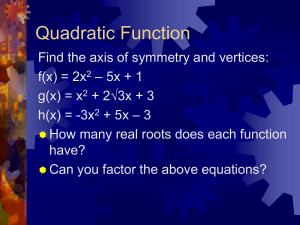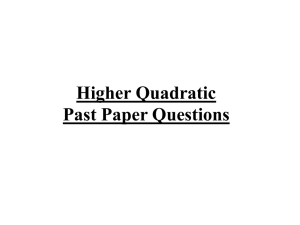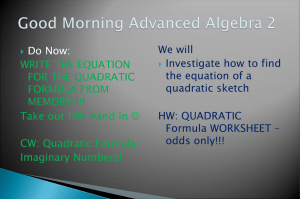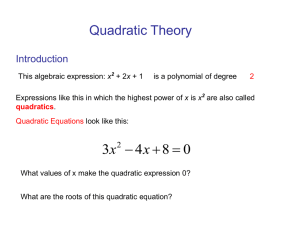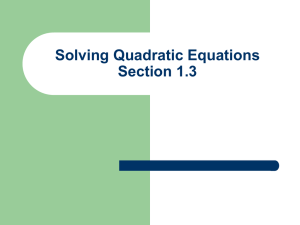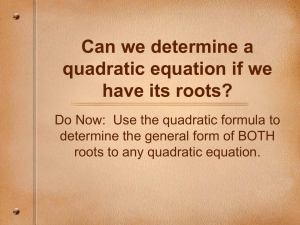Higher Maths 2.1
advertisement
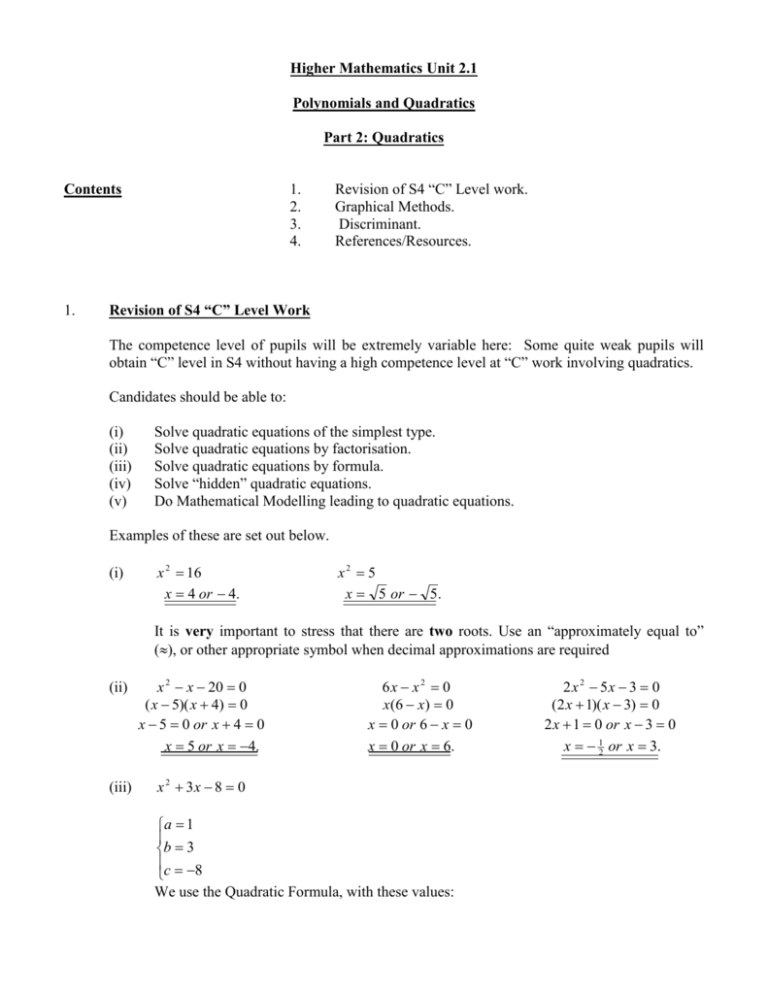
Higher Mathematics Unit 2.1 Polynomials and Quadratics Part 2: Quadratics Contents 1. 1. 2. 3. 4. Revision of S4 “C” Level work. Graphical Methods. Discriminant. References/Resources. Revision of S4 “C” Level Work The competence level of pupils will be extremely variable here: Some quite weak pupils will obtain “C” level in S4 without having a high competence level at “C” work involving quadratics. Candidates should be able to: (i) (ii) (iii) (iv) (v) Solve quadratic equations of the simplest type. Solve quadratic equations by factorisation. Solve quadratic equations by formula. Solve “hidden” quadratic equations. Do Mathematical Modelling leading to quadratic equations. Examples of these are set out below. (i) x 2 16 x 4 or 4. x2 5 x 5 or 5. It is very important to stress that there are two roots. Use an “approximately equal to” (), or other appropriate symbol when decimal approximations are required (ii) x 2 x 20 0 ( x 5)( x 4) 0 x 5 0 or x 4 0 x 5 or x 4. (iii) x 2 3x 8 0 6x x 2 0 x (6 x ) 0 x 0 or 6 x 0 x 0 or x 6. a 1 b 3 c 8 We use the Quadratic Formula, with these values: 2 x 2 5x 3 0 (2 x 1)( x 3) 0 2 x 1 0 or x 3 0 x 12 or x 3. x b b 2 4ac 2a 3 3 2 4(1)( 8) x 2 1 3 41 x 2 3 41 3 41 x or 2 2 x 1.70 or 4.70 (iv) x2 1 x 1 x ( x 2) x x 2 x 2 x 1 x2 2x 1 0 ( x 1) 2 0 x 1 0 (twice) x 1 (twice) (v) A carpet has length 4 feet greater than its breadth. Its area is 192 square feet, calculate its length and breadth. x x4 x( x 4) 192 and x 0. x 2 4 x 192 0 ( x 16)( x 12) 0 x 16 0 or x 12 0 x 16 or x 12 But x 0 here, so x 12 is the only valid solution. And so the breadth is 12 feet and the length is 16 feet. Notes 2. (a) (b) (c) (d) Weakest pupils will need much practice at factorisation. Care must be taken with calculator when using the Quadratic Formula. Use an “approximately equal to” symbol for decimal approximations. Quadratic Formula must be known; it is not on the “H” Grade Formula Sheet. Graphical Methods Again, competence will be variable here, but it is important that pupils develop a high sense of graphical awareness. Pupils should be able to: (i) (ii) (iii) (iv) Sketch graphs of quadratic functions. Solve quadratic inequations. Obtain (algebraically) coordinates of points where graphs meet/intersect. Obtain the formula for a quadratic function, given a sketch of its graph. Examples of these are listed below. (i) Sketch the graph of y 2 x 2 5 x 3. First, the graph is (happy or concave up), because of the 2x 2 term. On y axis, x 0 y 3. Hence the y-intercept has coordinates (0,3). y0 On x axis, 2 x 5x 3 0 2 (2 x 1)( x 3) 0 2 x 1 0 or x 3 0 x 12 or x 3 Hence the points of intersection with the x axis are ( 12 ,0) and (3,0). Now the graph may be sketched. 2 x 2 5x 3 y 12 O -3 3 x Worth reminding pupils a) how to find the x coordinate of the turning point b) how to then find the max or min value using this mid point. It is worthwhile to draw the axes first and mark the points as they are obtained. Do examples where the coordinates of the turning point and the equation of the symmetry axis have to be found. Graphs should be annotated, as above. (ii) Solve the inequation 2 x 2 5 x 3 0. First, sketch the graph, as in (i), above. Then use the graph to obtain the solution 12 x 3. Be very careful with, say x 2 16. Many people simply write down x 4 , which is simply wrong! Perhaps the best way to deal with this is to rearrange the inequality to the form x 2 16 0 . Now sketch the graph of y x 2 16 , as in (i), above, and obtain the solution intervals x 4 or x 4. It is worthwhile to consider an example such as: y 6 x x 2 . For what values of x is y 7.5 ? Sketch graph of y 6 x x 2 . Sketch the line y 7.5 on the diagram, and use the quadratic formula to find the numbers X 1 , X 2 where 6 x x 2 7.5 . Use your solutions to obtain the solution interval. First: Secondly: Thirdly: y 7.5 O X1 X2 6 x Some pupils will need much practice at quadratic inequations. y x 2 5x 8 (iii) y yx B A O x Find the coordinates of A and B, the points of intersection of the line and parabola. Remind pupils that in cases like this, full coordinates must be given and not just the x coordinates. (iv) Consider also examples of this type: y x2 y A B O x y 8 x2 Find the coordinates of the points of intersection of the two parabolas. (v) y f (x ) 16 O 2 4 x Find the equation of the parabola shown here. Method 1 It can be seen that y k ( x 2)( x 4). By substituting the coordinates (0,16), of the y-intercept, k will be found to have value 2: y k ( x 2)( x 4) 16 k (2)( 4) k 2. Method 2 For a parabola, y ax 2 bx c. Substitute the coordinates of the 3 points, starting with (0,8), into the general equation to find equations connecting a, b and c. the resulting equations are easily solved to find the values of a, b and c. y ax 2 bx c (0,16) 16 a(0 2 ) b(0) c c 16. (2,0) 0 4a 2b 16 2a b 8. (4,0) 0 16a 4b 16 4a b 4. Solving these equations in the usual way gives a 2, b 12, c 16. Hence f ( x) 2 x 2 12 x 16. Method 1 is more efficient, but care must be taken to ensure that pupils understand what is going on. Care must be taken when there is a turning point on the horizontal axis, for example, with a minimum turning point at (-2,0), the general equation would be y k ( x 2) 2 . This can be justified by considering two very close roots gradually “sliding towards each other” and merging in the limiting case to produce a double root. In the above case a typical set of equations would be y k ( x 1.99)( x 2.01) ,…….. y k ( x 1.9999)( x 2.0001),............ , and when the roots merge we have y k ( x 2) 2 . 3. Discriminant Start by using the Quadratic Formula to solve (say) the following equations: x 2 x 20 0, x 2 4 x 4 0, x 2 x 1 0, x 2 x 5 0. Important to relate this quadratic to its graph From this it will be seen that the value of b 2 4ac determines the nature of the roots. Thus we have: b 2 4ac <0 NO REAL ROOTS. b 2 4ac =0 ROOTS are EQUAL and RATIONAL (avoid talking of 1 root) b 2 4ac > 0 ROOTS are DISTINCT and REAL. If b 2 4ac is a perfect square the roots are rational and the quadratic can be factorised. SQA questions often deal with “real roots”. It is important to realise that the real roots may be either real and distinct or real and equal, so we have: Real roots b 2 4ac 0. Example For what value of k does the equation x 2 5 x (k 6) 0 have equal roots? Answer b 2 4ac = 0 stated or implied 1 2 (-5)2 - 4×(k+6) K=¼ Example Show that the equation (1 2k ) x 2 5kx 2k 0 has real roots for all integer Values of k. Answer 1 2 3 4 5 discriminant = ………… disc = (-5k)2 – 4(1 – 2k)(-2k) 9k2 + 8k eg draw a table, graph, complete the square complete proof and conclusion relating to disc 0. (3) (5) Notes (a) The condition for real roots is b 2 4ac 0 , since the roots may be real and distinct or real and equal. (b) Questions such as “The line with equation y x c is tangent to the parabola with equation y x 2 3x , find the value of c.”, should be done. (c) Give pupils practice at “past paper” questions on this topic. (d) Some pupils will not know the meanings of the terms “rational number”, “irrational number”, etc. (e) The relationship between the discriminant of a quadratic equation and the graph of the corresponding quadratic function must be known and understood. (i) Distinct Real Roots [Graph crosses horizontal axis at two distinct points.] (ii) Equal Roots [Exactly one point of contact with the horizontal axis.] (iii) No Real Roots [Graph does not meet the horizontal axis.] 4. References/Resources 1. 2. “H.H.M.” pp 35-44. “M.I.A” pp115 - 123


